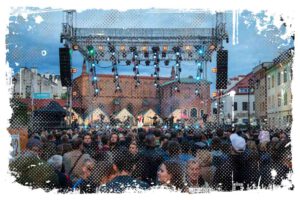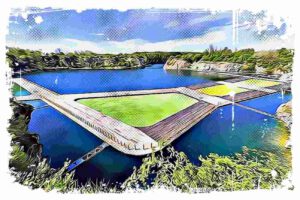St. Mary’s Trumpet Call – It’s more than a melody. It’s a touch of Polish history, wrapped in the echoes of a trumpet. Let me say, the melody, with its abrupt interruption, brilliantly captures the essence of Poland. It’s a statement that renowned Professor Wiktor Zin once made, and it couldn’t be more true.

This melody, known as the Krakow Trumpet Call or Bugle Call , has been a rhythmic part of the radio airwaves for nearly a century, with a brief pause during the troubled times of World War II. The first reference to this hymn can be traced way back to 1392. I think it’s fascinating how the original tune might have sounded. Can you imagine?
I am convinced that Krakow may be the world's longest-standing city in keeping the tradition of the bugle call alive. It's like a timeless tune, living through the ages, echoing across the city.
Kraków Trumpet Call – A Noteworthy Tradition

Up in the St. Mary’s tower, you’ll find the written notation of the St. Mary’s horn hymn. This is what the bugle players refer to, keeping the tradition alive and well. If you want a taste of history, it’s worth to say that this notation is in line with the protection certificate issued by the Patent Office of the Republic of Poland, marking the bugle call as a trademark. It’s a small piece of history in the tower’s heart.
The Sworn Trumpeter – A Commitment to Melody

Throughout the years, there’s been a unique bond between the city and its trumpeter. It’s like a sacred promise. The book of oaths of city officials and servants, known as „Liber iuramentorum„, carries the city trumpeter’s oath. Established in the year 1671, it was the bond of melody and duty.
↳ Make sure to read my guide to the most amazing places to stay in Kraków:
How to Find Best Place to Stay in Krakow Old Town – Your Guide
The Echoes of the Past – Historical Sheet Music
I can tell, the call is more than a melody. It’s a symbol, a story, a part of Krakow’s identity. For instance, check out this print by Piotr Stachiewicz from 1888. It paints a picture of St. Mary’s Church towers with a trumpeter standing tall, armored like a hussar. Accompanying this visual tale is the notation of the Krakow bugle call.

Fast forward to 1923, and we have another drawing by Stachiewicz, showing the same towers against the backdrop of a symbolic sunrise, with the bugle call’s notes adorning the left side.
And there’s this half-fold postcard from 1902, with a beautiful view of the Market Square with St. Mary’s Church and a bugle call. The caption under the notes reads: „A wake-up call every hour to the four corners of the world from the Maryacka tower in Krakow”.

The Trumpets of Krakow

Imagine, if you will, a trumpet from 1886-1928. A faithful servant to the bugle callers of Krakow. Inscribed on the trumpet’s tube are the names of city firefighters who filled the air with the bugle call from the Mariacka Tower. These included sergeants Andrzej Janas, Walenty Kwarczak, Piotr Pitra, and platoon members Antoni Dołęga, Franciszek Kubarek, and many others. This historical instrument holds a certificate of authenticity from Adam Chmiel, the 1928 director of the Archives of Historical Records of the City of Krakow.

Next, there’s a trumpet that saw use in the 1920s. Emblazoned on its tube is a plaque revealing the name of the manufacturer – IL Haisner, Instrument Fabrik from Königsberg. The trumpet bears another small plate on a chain, telling its story – „Trumpet bugler from the Mariacka Tower from the 1920s age”.This trumpet made a significant contribution in 2000 when it was auctioned by Plus GSM for PLN 15,000, aiding the restoration of the Kościuszko Mound.

Then there’s the VMI Manufaktur Germany model trumpet, faithfully used by senior fire master Kazimierz Czerw for 17 years. This trumpet has played for some truly remarkable moments. Imagine the solemn, yet hopeful tune welcoming Pope John Paul II in 1995. The mournful hymn honoring the victims of the 2001 World Trade Center attacks. The sorrowful goodbye to the presidential couple after the plane crash in Smolensk in 2010. I believe that every note played on this trumpet tells a story of history, hope, and resilience.
The Beauty of the Bugle Call – Artistic Tributes
There’s something unique about the way art captures history. Take, for instance, the oil painting by Piotr Stachiewicz titled „Hejnał na Wieży Mariacka”.Painted around 1892, it beautifully depicts the interior of the bugle call room and a fireman playing the bugle call. It’s like a silent, visual echo of the melody.

Or consider another oil painting by Stachiewicz called „Strażak na Wieży Mariackiej / Firefighter at Mariacka Tower”.Painted in 1903, it shows a bugle caller on a wooden porch surrounding the octagonal part of the higher tower of St. Mary’s Church. The moment is frozen in time, a beautiful testament to the enduring tradition of the bugle call.

The Treasured Mementos of the Bugle Call
Up in the tower, you can find an intriguing list named „Famous buglers playing the bugle call…” Its author and date are shrouded in mystery, but it’s kept „in memory” of all those who have had the honor of playing the bugle call.

And there’s this postcard reproduction of a watercolor painting from 1935 that depicts a firefighter. It’s pinned atop the bugle call, a silent guardian of the tradition.
A Family Tradition and Three Generations on the Tower
I think it’s worth mentioning the Kołton family. Three generations of them have dedicated their lives to the bugle call. There’s Jan Kołton, the elder, who played the bugle call for 35 years. His son, Jan Kołton, the younger, was in service for 33 years from 1971 to 2004. And now, the third generation, Michał Kołton, has been in service since 2005. It wasn’t uncommon for both father and son to play the bugle call, a tradition echoing down the family line.
Then, there are the bugle callers who have marked different periods of Kraków’s history. First, Adolf Śmietana, who served for 36 years from 1926 to 1962. He had the honor of playing the first bugle call in Krakow after it was liberated from German occupation in 1945. Then there’s Kazimierz Pudełko, who played the bugle call from 1973 to 1994. And the fire level Casimir Czerw, who you’ve already met.
Honoring the Trumpeters – Hejnał Day and Beyond
On July 3, 2006, the State Fire Service and the Marksman Brotherhood declared the day as Hejnał Day. A plaque was unveiled at the entrance to St. Mary’s Church tower to commemorate Antoni Dołęga, a bugle caller who died on duty in 1901.
Another trumpeter who deserves mention is firefighter Jan Sergiel. With 22 years of experience on the bugle call, Sergiel is one of the seven current trumpeters of the Municipal Fire Brigade Headquarters in Krakow. In 2006, on the first anniversary of the death of Pope John Paul II, he won a competition for an arrangement for two trumpets of the melody to the song Barka. Ever since, it’s been played in this arrangement from St. Mary’s Basilica every first Saturday of the month at 21.37.

So remember, each trumpet call isn’t just a tune. It’s a story, a legacy, a piece of history. It’s a melody woven into the very fabric of Krakow, played by people who have dedicated their lives to the tradition. And with every note, they breathe life into history, making it resonate in the here and now.
References:
- https://pl.wikipedia.org/wiki/Hejna%C5%82_mariacki



